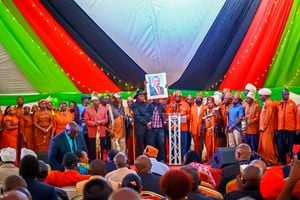Obama’s strategy for Africa and the continent’s reality
A fortnight ago, President Barack Obama launched The US Strategy Toward Sub-Saharan Africa (the strategy).
It sets out to consolidate and advance the initiatives and vision of his administration in balancing between long-term US interests and short-term imperatives towards this region.
In his preface to the strategy, President Obama points to strengthening democratic institutions and boosting broad-based economic growth as the key factors that will shape Africa’s future.
It may be helpful to look more closely at this strategy in the light of what America is actually doing around the continent and, perhaps more importantly, what Sub-Saharan Africa has been asking Washington to engage on.
The core US interest in the region is stated as ensuring the security of the US, her citizens and allies; promoting states that are partners of the US in global matters, expanding US trade and investment opportunities, preventing conflict and fighting poverty.
The strategy identifies four key objectives: Strengthen democratic institutions, spur economic growth and development, advance peace and security, and promote opportunity.
From his lecture at Taifa Hall in Nairobi before declaring his candidature, through his historic speech at Cairo University to his address outside parliament of Ghana, Obama has remained true in his commitment to strengthening democratic institutions and practices.
His administration continues to support young leaders in politics, civil society and business to grow what US sees as positive democratic models.
In countries like Kenya, this has at times taken the form of creating and nurturing organisations growing new players dedicated to challenges for political leadership.
A major downside to this democratic push has been twofold. Haphazard and uncoordinated interventions that do not shore up across the board growth in democratic culture bring modest returns compared to resources used.
Secondly, an over-emphasis on civil society as opposed to strengthening formal political institutions engenders more horizontal competition than opportunities for upward political progression for younger players.
In recent years, the US has built strategic friendships at times with a blind eye on the decline of democratic governance.
Countries like Ethiopia, Uganda and Rwanda, key allies in security matters, have drawn modest critique on their deviation from established democratic norms.
America is looking to saw seeds of democratic renewal where democracy is already sprouting, while going slow in those countries most in need of capacity in order not to upset its strategic allies.
America’s security pillar dominated by the war on terror continues to receive overwhelming priority. It has seen the rapid expansion of AFRICOM with bases in five countries across the continent.
Cases like Mali have shown how soldiers empowered by US resources have turned their guns on democratically elected governments and negated both the political and security goals of US support.
Perhaps the weakest pillar of the US strategy is the most important one. Economic development. Since Obama became president, African lobbying has fought for a comprehensive negotiated compact between Sub-Saharan Africa and the US whose key component is building on the gains of Agoa, develop a clear and predictable regime of market access offers and a basket of predictable resources to address supply side constraints across the continent.
Africa has sought to deepen a compact of trade and economic development while overcoming the infrastructure nightmare perverted by the logic of extractive economies of the past century.
A core component of this is physical infrastructure. We need roads and railways to connect the regional market with factors of production and shorten distances and costs of transport to the sea.
Addressing administrative impediments to the movement of goods is useful. But the presence of road and rail networks precedes trade facilitation.
Yet the Obama strategy errs in the opposite direction. It seeks to address the regulatory environment for trade by improving economic governance, reducing procedural barriers to regional trade flows and strengthening compliance with sanitary and phytosanitary requirements for African exports.
Where Africa sought a transformation of the Agoa into an agreement, Obama gives a brief extension to Agoa and reverts to governance questions.
It is no wonder that Africa is increasingly looking East for priority funding of infrastructure. While China builds the roads on which Africa trades with itself and the rest of the world, US is growing the procedures which will ease traffic on these roads.
Quite a partnership this. In Africa’s trade, American software will continue to run on Chinese hardware.
As Obama approaches the end of his first term, it is emerging that on his watch we have witnessed the decline of resource flows initiated by his Republican predecessor.
Agoa benefits have steadily declined except for petroleum exports. Programmes like the Millenium Challenge Account and the Global Aids support have declined. Structured engagement has given way to lectures on governance.
Dr Kituyi is a director at the Kenya Institute of Governance [email protected]




